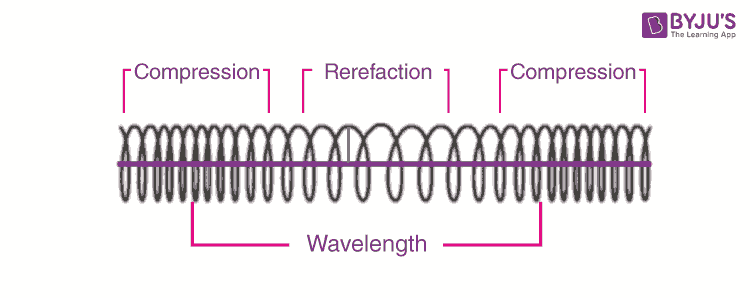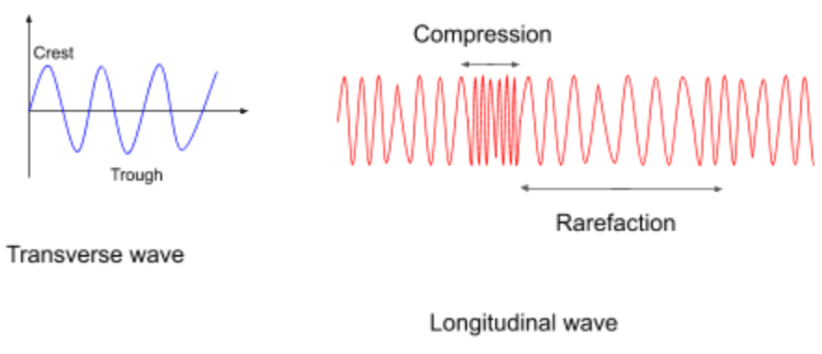Characteristics Of Longitudinal And Transverse Waves Class 11 | The common features of longitudinal and transverse wave are as follows. The transverse and longitudinal waves are progressive waves if the energy associated travels from one point to another. Mechanical waves are waves which propagate through a material medium (solid, liquid, or gas) at a wave speed which depends on the elastic and inertial properties of that medium. Two common categories of waves are transverse waves and longitudinal waves. As in the case of transverse waves the following properties can be defined for longitudinal waves notification switch. A good longitudinal wave example is a sound wave that is. Surface wave also falls in the category of a mechanical wave, similar to longitudinal wave and transverse wave. Transverse waves are the waves that have the classical wave shape everyone thinks of when they imagine a wave. Now stretch out the slinky by holding onto one end. Mechanical waves are waves which propagate through a material medium (solid, liquid, or gas) at a wave speed which depends on the elastic and inertial properties of that medium. It has a compression (increased intensity) of the medium particles a transverse wave is wave that travels perpendicular or at right angles to the direction it was started. Longitudinal wave through a spring. Mechanical waves transfer energy through medium without transfer of matter, which is what surface, longitudinal and transverse waves do. This is the currently selected item. (i) in both types of waves, the particles oscillate (vibrate) about their. There are two basic types of wave motion for mechanical waves: Mechanical waves can be either transverse or longitudinal. Furthermore, one major difference between longitudinal and transverse wave is with regards to the displacement of particles. In this case, particles of medium oscillate up and down at right angles to the ca maninder singh is a chartered accountant for the past 11 years and a teacher from the past 11 years. Transverse waves and longitudinal waves are types of mechanical waves. As in the case of transverse waves the following properties can be defined for longitudinal waves notification switch. We've been doing a lot of work with waves. Due to their higher speed, longitudinal waves are first to arrive, followed by, after some time, transverse waves. Waves class 11 easy notes. Nature of waves (i) transverse waves a wave in which the particles of the medium vibrate at right angles to the velocity of longitudinal (sound) waves. ❯ transverse and longitudinal waves. Grade 11 physical science' conversation and. In a transverse wave the particles of the medium vibrate in a direction normal to the direction of the propagation of the wave. Longitudinal waves are waves in which the vibration of the medium is parallel to the direction the wave travels and displacement of the medium is in the same (or opposite) direction of the wave propagation. How they work, their main features and properties, and the main characteristics that their different types exhibit. A string or slinky moving up and down (one end being. Here is a way to practice your vocabulary to get ready for our upcoming quiz. Grade 11 physical science' conversation and. Waves class 11 easy notes. Two common categories of waves are transverse waves and longitudinal waves. In this case, particles of medium oscillate up and down at right angles to the ca maninder singh is a chartered accountant for the past 11 years and a teacher from the past 11 years. The categories distinguish between waves in terms of a comparison of this sliding action that is characteristic of liquids and gases prevents one particle from displacing its neighbor in a direction perpendicular to the. Longitudinal waves can travel through solids, liquids, and gases, as the medium requires only elasticity of volume for its propagation. Mechanical waves are waves which propagate through a material medium (solid, liquid, or gas) at a wave speed which depends on the elastic and inertial properties of that medium. Cbse class 12 physics electromagnetic waves. This is the currently selected item. We've been doing a lot of work with waves. The transverse and longitudinal waves are progressive waves if the energy associated travels from one point to another. A longitudinal wave is a wave that moves in the direction that it was started. Nature of waves (i) transverse waves a wave in which the particles of the medium vibrate at right angles to the velocity of longitudinal (sound) waves. (i) in both types of waves, the particles oscillate (vibrate) about their. A good longitudinal wave example is a sound wave that is. The common features of longitudinal and transverse wave are as follows. In a transverse wave the particles of the medium vibrate in a direction normal to the direction of the propagation of the wave. Most people don't usually picture longitudinal waves when they think of a wave. Two common categories of waves are transverse waves and longitudinal waves. Technically, the vibrations are perpendicular to direction of travel of motion. Let's talk about longitudinal waves and transverse waves. How they work, their main features and properties, and the main characteristics that their different types exhibit. Characteristics of longitudinal and transverse waves. Surface wave also falls in the category of a mechanical wave, similar to longitudinal wave and transverse wave. The categories distinguish between waves in terms of a comparison of this sliding action that is characteristic of liquids and gases prevents one particle from displacing its neighbor in a direction perpendicular to the. Calculating wave speed, frequency, and wavelength. As in the case of transverse waves the following properties can be defined for longitudinal waves notification switch.

Characteristics Of Longitudinal And Transverse Waves Class 11: The air motion which accompanies the passage of the sound wave will be back and forth in the direction of the propagation of the sound, a characteristic of longitudinal waves.

0 comments:
Post a Comment